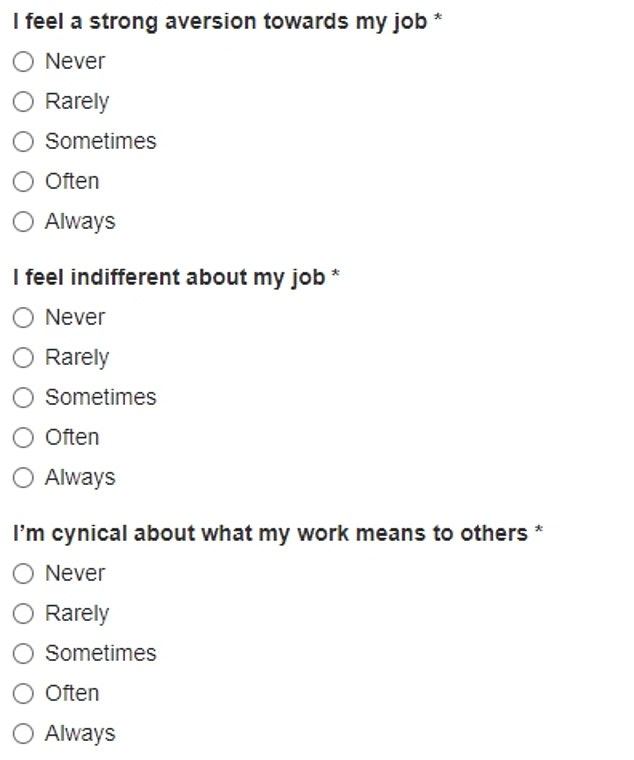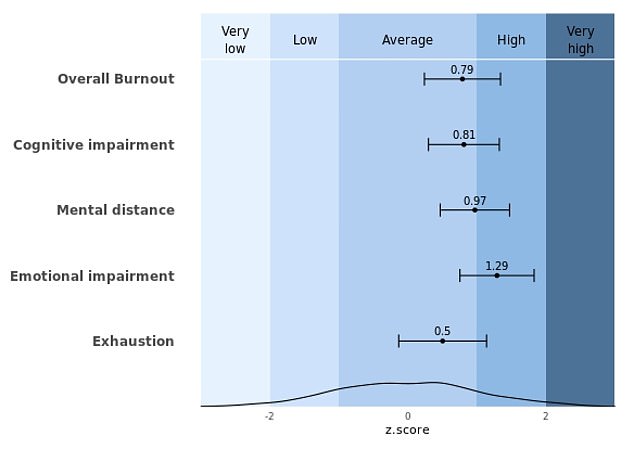Are you at risk of burnout? Take the 23-question test, created by scientists, to find out
Short bursts of stress, exhaustion and disinterest are common in any job.
But how do you know that you are at risk of burnout due to that pressure?
Researchers in Norway have now created a simple 23-question test that claims to reveal who is at risk.
The quiz prompts people to rank their feelings about their work from ‘never’ to ‘always’ through statements about energy levels, motivation and emotions.
Rather than a medical problem, burnout is a feeling of mental or physical exhaustion and is the body’s response to a prolonged, demanding situation, the researchers said.
For some people, burnout can be stopped gradually through adjustments that ease workload, such as reducing workload, taking annual leave, and prioritizing sleep.
But others can struggle for years if the cause is not addressed.
The burnout quiz encourages people to rank their feelings towards their work from ‘never’ to ‘always’ through statements about energy levels, motivation and emotions

The statements fell into four different areas, including exhaustion (“I don’t have the energy to start a new work day), mental distancing (“I feel indifferent about my work”), cognitive impairment (“I am forgetful and distracted at work’). ) and emotional limitations (‘I get angry or sad at work without knowing why’)

Burnout is then ranked on a scale from ‘very low’ to ‘very high’ based on responses from others in that person’s country
There is no single international test to assess burnout, with doctors using different questionnaires that use different metrics.
This led a team from the Norwegian University of Science and Technology, led by Leon De Beer, associate professor of industrial and organizational psychology, to create a new burnout assessment tool to help those suffering from the early symptoms to trace.
They reviewed 12 existing tests as part of the process and limited their quiz to 23 statements with multiple-choice questions ranging from “never” to “always.”
The statements fell into four different areas, including exhaustion (“I don’t have the energy to start a new work day), mental distancing (“I feel indifferent about my work”), cognitive impairment (“I am forgetful and distracted at work’). ) and emotional limitations (‘I get angry or sad at work without knowing why’).
Burnout is then ranked on a scale from ‘very low’ to ‘very high’, based on responses from others in that person’s country.
To test whether the tool worked, the researchers recruited 493 employees, average age 45, who completed the tool.
The results showed that 12.9 percent of volunteers were at high risk of burnout. This would be lower than in other EU countries because, according to the researchers, the country has a better work-life balance.
They said the test works across cultures and genders but does not provide formal diagnosis or medical advice.
Those concerned about their work-related stress should visit a doctor, she added.
The team concluded that feeling mentally exhausted, struggling to be enthusiastic, difficulty concentrating, and overreacting without meaning to, consistently over a period of weeks, are hallmarks of burnout.
They said identifying the early signs before they have gone too far is crucial to reducing the risk of harmful knock-on effects such as cardiovascular disease, joint pain, sleep problems and depression.
The researchers are now testing the tool in more than 30 countries, which will show which countries have the highest prevalence of burnout.
Mr De Beer says: ‘Our research shows that BAT (the name of the test) is a good tool for identifying the risk of burnout.’
The tool can identify who needs the most urgent care so the risk of burnout can be reduced, the team said.
Professor Marit Christensen, professor of industrial and organizational psychology, added: ‘We can tackle burnout through individual treatment.
‘But there is little point in people returning to a workplace where the demands are too high and there are few resources.
‘There is a good chance that the employee will become ill again.
‘It is therefore important to create good working conditions and structures that guarantee the health of employees.’
